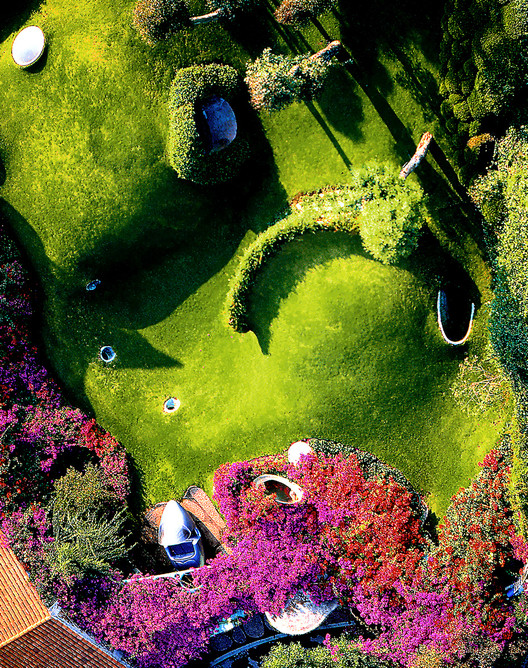Britten Pears Archive Stanton Williams
2013-07-21 01:00
架构师提供的文本描述。布里顿皮尔斯档案馆,斯坦顿威廉姆斯的新的被动档案馆为布里滕-皮尔斯基金会(BPF),收藏了大量的音乐手稿,信件,照片和唱片的作曲家本杰明布里顿和男高音彼得皮尔斯。这个档案馆最初由布里顿和皮尔斯组成,是他们自己收藏的藏书、手稿以及印刷乐谱和唱片的图书馆,现在已发展成为该国最重要的音乐研究和奖学金中心之一。2005年,该收藏品正式获得指定地位,以确认其重要性。
Text description provided by the architects. The Britten Pears Archive, Stanton Williams’ new passive archive building for the Britten–Pears Foundation (BPF), houses the extensive collection of music manuscripts, letters, photographs and recordings of the composer Benjamin Britten and tenor Peter Pears. Originally assembled by Britten and Pears as a working library of their own collections of books, manuscripts and printed scores and recordings, the archive has now grown into one of the country’s most important centres for music research and scholarship. In 2005 the collection was officially given Designated status in recognition of its significance.
这座档案馆是对位于萨福克阿尔德堡的红楼遗址的补充,这座二级建筑列出了布里顿和他的合作伙伴皮尔斯(Pears)的前家,并在2013年6月阿尔德堡音乐节上及时完成了布里顿百年纪念活动。
The archive building complements the site of The Red House in Aldeburgh, Suffolk, the Grade II listed former home of Britten and his partner Pears and has been completed in time for Britten’s Centenary celebrations at the Aldeburgh music festival in June 2013.
斯坦顿威廉斯的设计根植于它的背景和适合上市的房子和花园,提供了最佳的环境条件,通过开拓性的低能手段保存重大收藏,实现被动的档案环境。
Stanton Williams’ design roots the building firmly in its context and is appropriate to the listed house and garden, providing optimum environmental conditions for preservation of the significant collection through pioneering low-energy means, achieving a passive archive environment.
建筑表现为两种联锁形式,反映了建筑的内部功能。这个概念是“盒子里的鸡蛋”:厚厚的、绝缘良好的墙壁包围着主储藏室,周围是一个缓冲空间,有助于调节外部环境和内部材料之间的温度和相对湿度。
The building is expressed as two interlocking forms, reflecting the internal functions. The concept is that of an ‘egg in a box’: thick, well insulated walls enclose the main storage room, surrounded by a bufferspace which helps moderate the temperature and relative humidity between the outside environment and the material within.
北面的书卷包括职员办公室、辅助空间和自修室,西面和北面都有宽大的窗户,可以看到红楼花园的景色,给人一种与现场联系的感觉。南部的藏书收藏了这些档案,从地面升起,以保护它免受洪水的威胁。这种功能和效率的概念是建立在一个传统的基础上,建立宝库,粮仓商店和神社,并给予‘宝贵’性质的收藏。
The volume to the north contains the staff offices, support spaces and a study room, with generous windows on the west and north façades allowing views out to The Red House gardens, giving a sense of connection with the site. The southern volume houses the archive collection, raised from the ground to protect it from flood risk. This functional and efficient concept is based on a tradition of building treasure houses, granary stores and shrines and gives form to the ‘precious’ nature of the collection.
外墙完全是用实心砖砌成的。砖块在视觉上将建筑物与场地的其他部分连接起来,并提供热质量,以帮助调节建筑物内的环境。这对于被动控制,确保建筑物的低能耗和高环境标准是必不可少的.
The outer building walls are constructed entirely from solid brick. The bricks connect the building visually with the rest of the site and provides thermal mass to help moderate the conditions within the building. This is essential for passive control ensuring low-energy and high environmental standards for the building.
工作人员区的绿色刚玉屋顶有助于将建筑物与景观融为一体,鼓励生物多样性。
A green sedum roof on staff areas helps blend the building with the landscape, encouraging biodiversity.
在内部,这些材料仅限于清水混凝土泡沫和柱(提供热质量和冷却)和木材墙衬里,地板和窗户,以提供温暖和质地。
Internally, the materials are limited to fairfaced concrete soffits and columns (providing thermal mass and cooling) and timber wall linings, floors and windows to provide warmth and texture.
这个新的档案馆第一次在布里顿创作他的音乐的地方把这个国际上重要的收藏集中在一个中心位置,改善了工作人员的工作空间、访问和安全。
The new archive brings together this internationally important collection in one central place for the first time in the very place where Britten created his music, improving staff workspace, access and security.
重新安置档案馆创造了机会,腾出场地内现有建筑的空间,最重要的是,布里顿1958年至1970年工作的作曲工作室,以及像战争安魂曲这样的杰作,已经被重新创造,供游客体验。
Re-housing the archive created opportunities to free up space within the existing buildings on the site, most importantly, the composition studio in which Britten worked from 1958 to 1970, and where masterpieces such as War Requiem were written, has been re-created for visitors to experience.
 举报
举报
别默默的看了,快登录帮我评论一下吧!:)
注册
登录
更多评论
相关文章
-

描边风设计中,最容易犯的8种问题分析
2018年走过了四分之一,LOGO设计趋势也清晰了LOGO设计
-

描边风设计中,最容易犯的8种问题分析
2018年走过了四分之一,LOGO设计趋势也清晰了LOGO设计
-

描边风设计中,最容易犯的8种问题分析
2018年走过了四分之一,LOGO设计趋势也清晰了LOGO设计








































































































